DODGE RAM SRT-10 2006 Service Repair Manual
Manufacturer: DODGE, Model Year: 2006, Model line: RAM SRT-10, Model: DODGE RAM SRT-10 2006Pages: 5267, PDF Size: 68.7 MB
Page 1621 of 5267
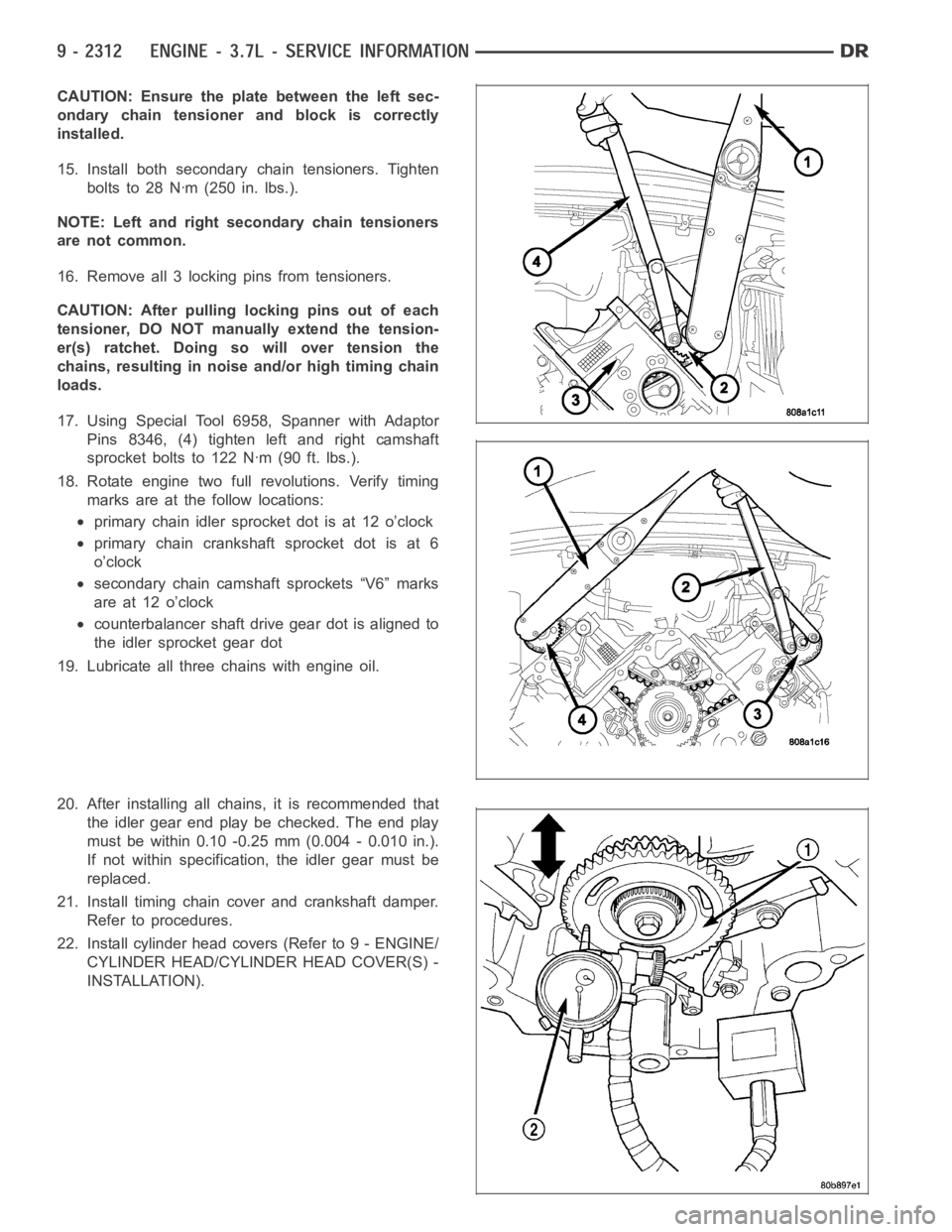
CAUTION: Ensure the plate between the left sec-
ondary chain tensioner and block is correctly
installed.
15. Install both secondary chain tensioners. Tighten
boltsto28Nꞏm(250in.lbs.).
NOTE: Left and right secondary chain tensioners
are not common.
16. Remove all 3 locking pins from tensioners.
CAUTION: After pulling locking pins out of each
tensioner, DO NOT manually extend the tension-
er(s) ratchet. Doing so will over tension the
chains, resulting in noise and/or high timing chain
loads.
17. Using Special Tool 6958, Spanner with Adaptor
Pins 8346, (4) tighten left and right camshaft
sprocket bolts to 122 Nꞏm (90 ft. lbs.).
18. Rotate engine two full revolutions. Verify timing
marks are at the follow locations:
primary chain idler sprocket dot is at 12 o’clock
primary chain crankshaft sprocket dot is at 6
o’clock
secondary chain camshaft sprockets “V6” marks
are at 12 o’clock
counterbalancer shaft drive gear dot is aligned to
the idler sprocket gear dot
19. Lubricate all three chains with engine oil.
20. After installing all chains, it is recommended that
the idler gear end play be checked. The end play
must be within 0.10 -0.25 mm (0.004 - 0.010 in.).
If not within specification, the idler gear must be
replaced.
21. Install timing chain cover and crankshaft damper.
Refer to procedures.
22. Install cylinder head covers (Refer to 9 - ENGINE/
CYLINDER HEAD/CYLINDER HEAD COVER(S) -
INSTALLATION).
Page 1622 of 5267
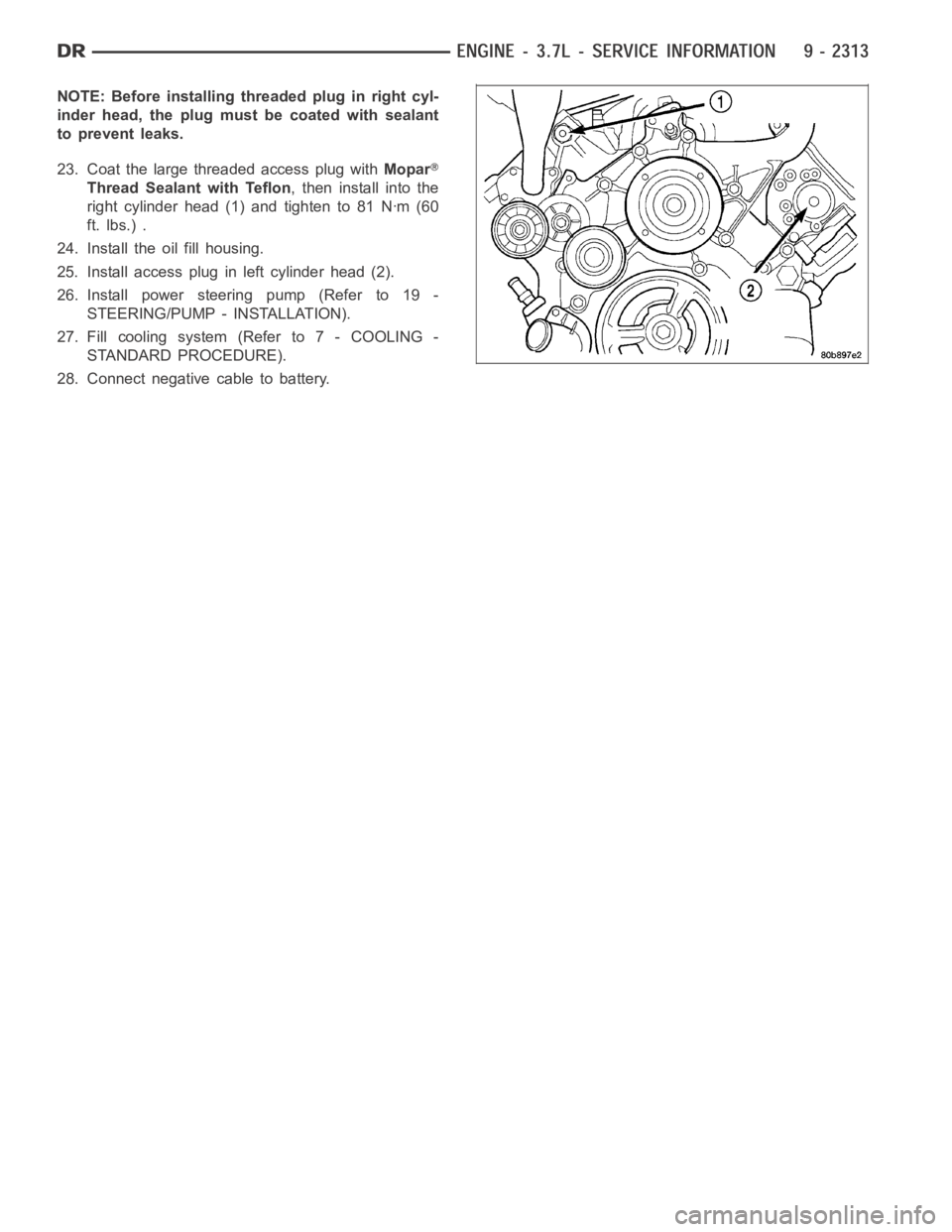
NOTE: Before installing threaded plug in right cyl-
inder head, the plug mustbecoatedwithsealant
to prevent leaks.
23. Coat the large threaded access plug withMopar
Thread Sealant with Teflon, then install into the
right cylinder head (1) and tighten to 81 Nꞏm (60
ft. lbs.) .
24. Install the oil fill housing.
25. Install access plug in left cylinder head (2).
26. Install power steering pump (Refer to 19 -
STEERING/PUMP - INSTALLATION).
27. Fill cooling system (Refer to 7 - COOLING -
STANDARD PROCEDURE).
28. Connect negative cable to battery.
Page 1623 of 5267
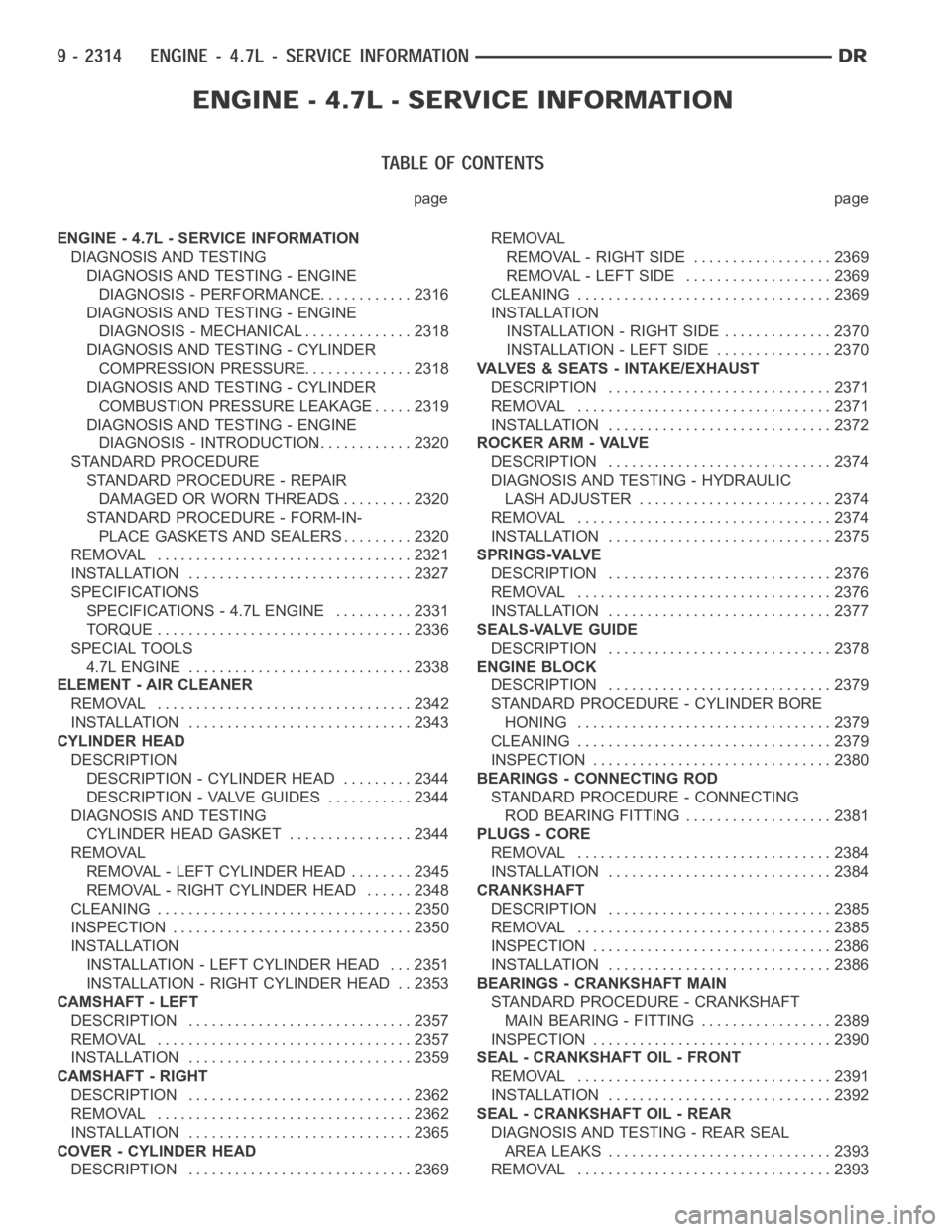
page page
ENGINE - 4.7L - SERVICE INFORMATION
DIAGNOSIS AND TESTING
DIAGNOSIS AND TESTING - ENGINE
DIAGNOSIS - PERFORMANCE............. 2316
DIAGNOSIS AND TESTING - ENGINE
DIAGNOSIS - MECHANICAL............... 2318
DIAGNOSIS AND TESTING - CYLINDER
COMPRESSION PRESSURE............... 2318
DIAGNOSIS AND TESTING - CYLINDER
COMBUSTION PRESSURE LEAKAGE...... 2319
DIAGNOSIS AND TESTING - ENGINE
DIAGNOSIS - INTRODUCTION............. 2320
STANDARD PROCEDURE
STANDARD PROCEDURE - REPAIR
DAMAGED OR WORN THREADS.......... 2320
STANDARD PROCEDURE - FORM-IN-
PLACE GASKETS AND SEALERS.......... 2320
REMOVAL ................................. 2321
INSTALLATION ............................. 2327
SPECIFICATIONS
SPECIFICATIONS - 4.7L ENGINE .......... 2331
TORQUE ................................. 2336
SPECIAL TOOLS
4.7L ENGINE ............................. 2338
ELEMENT - AIR CLEANER
REMOVAL ................................. 2342
INSTALLATION ............................. 2343
CYLINDER HEAD
DESCRIPTION
DESCRIPTION - CYLINDER HEAD ......... 2344
DESCRIPTION - VALVE GUIDES ........... 2344
DIAGNOSIS AND TESTING
CYLINDER HEAD GASKET................ 2344
REMOVAL
REMOVAL - LEFT CYLINDER HEAD ........ 2345
REMOVAL - RIGHT CYLINDER HEAD ...... 2348
CLEANING ................................. 2350
INSPECTION ............................... 2350
INSTALLATION
INSTALLATION - LEFT CYLINDER HEAD . . . 2351
INSTALLATION - RIGHT CYLINDER HEAD . . 2353
CAMSHAFT - LEFT
DESCRIPTION ............................. 2357
REMOVAL ................................. 2357
INSTALLATION ............................. 2359
CAMSHAFT - RIGHT
DESCRIPTION ............................. 2362
REMOVAL ................................. 2362
INSTALLATION ............................. 2365
COVER - CYLINDER HEAD
DESCRIPTION ............................. 2369REMOVAL
REMOVAL - RIGHT SIDE .................. 2369
REMOVAL - LEFT SIDE ................... 2369
CLEANING ................................. 2369
INSTALLATION
INSTALLATION - RIGHT SIDE .............. 2370
INSTALLATION - LEFT SIDE ............... 2370
VALVES & SEATS - INTAKE/EXHAUST
DESCRIPTION ............................. 2371
REMOVAL ................................. 2371
INSTALLATION ............................. 2372
ROCKER ARM - VALVE
DESCRIPTION ............................. 2374
DIAGNOSIS AND TESTING - HYDRAULIC
LASH ADJUSTER ......................... 2374
REMOVAL ................................. 2374
INSTALLATION ............................. 2375
SPRINGS-VALVE
DESCRIPTION ............................. 2376
REMOVAL ................................. 2376
INSTALLATION ............................. 2377
SEALS-VALVE GUIDE
DESCRIPTION ............................. 2378
ENGINE BLOCK
DESCRIPTION ............................. 2379
STANDARD PROCEDURE - CYLINDER BORE
HONING ................................. 2379
CLEANING ................................. 2379
INSPECTION............................... 2380
BEARINGS - CONNECTING ROD
STANDARD PROCEDURE - CONNECTING
ROD BEARING FITTING ................... 2381
PLUGS - CORE
REMOVAL ................................. 2384
INSTALLATION ............................. 2384
CRANKSHAFT
DESCRIPTION ............................. 2385
REMOVAL ................................. 2385
INSPECTION............................... 2386
INSTALLATION ............................. 2386
BEARINGS - CRANKSHAFT MAIN
STANDARD PROCEDURE - CRANKSHAFT
MAIN BEARING - FITTING ................. 2389
INSPECTION............................... 2390
SEAL - CRANKSHAFT OIL - FRONT
REMOVAL ................................. 2391
INSTALLATION ............................. 2392
SEAL - CRANKSHAFT OIL - REAR
DIAGNOSIS AND TESTING - REAR SEAL
AREA LEAKS . ............................ 2393
REMOVAL ................................. 2393
Page 1624 of 5267
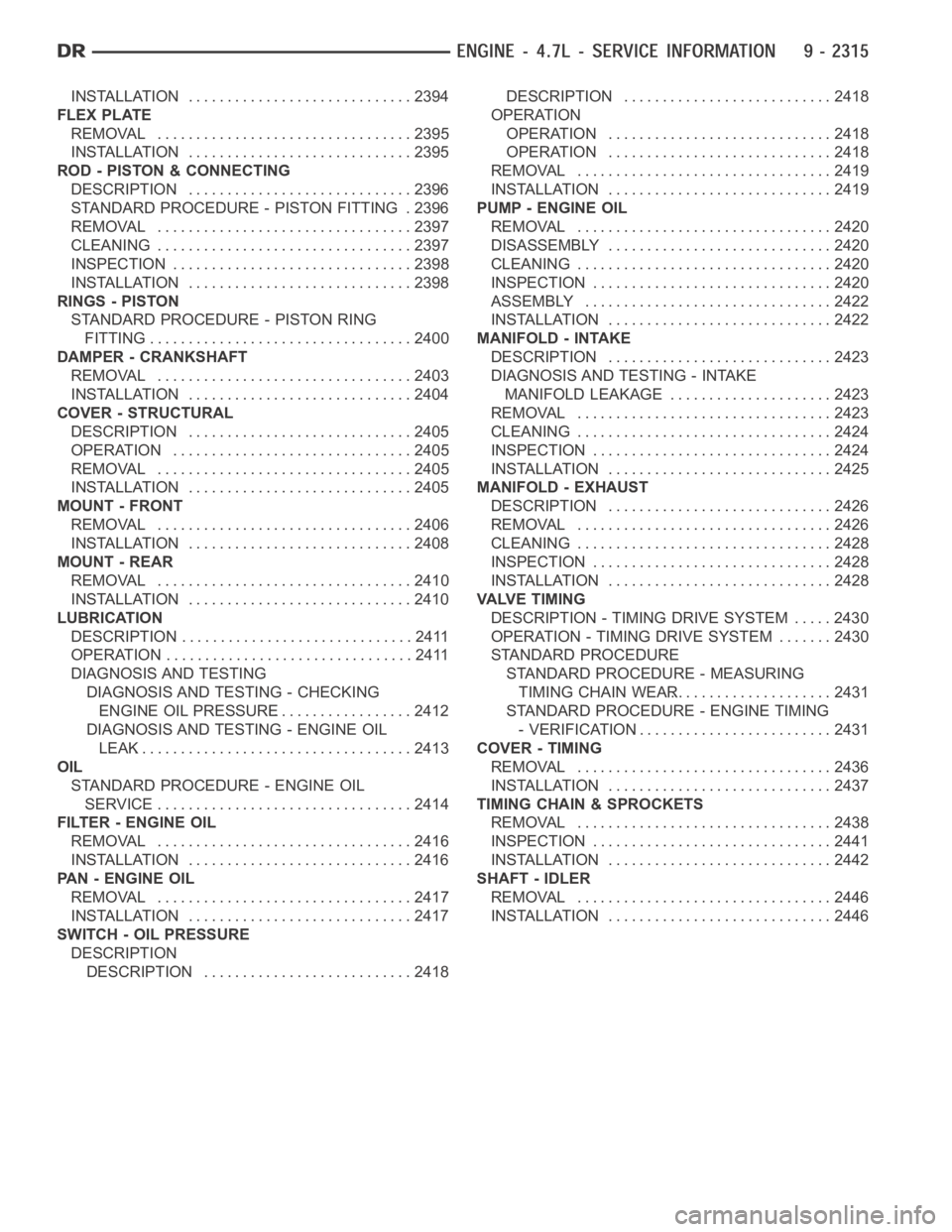
INSTALLATION ............................. 2394
FLEX PLATE
REMOVAL ................................. 2395
INSTALLATION ............................. 2395
ROD - PISTON & CONNECTING
DESCRIPTION ............................. 2396
STANDARD PROCEDURE - PISTON FITTING . 2396
REMOVAL ................................. 2397
CLEANING ................................. 2397
INSPECTION ............................... 2398
INSTALLATION ............................. 2398
RINGS - PISTON
STANDARD PROCEDURE - PISTON RING
FITTING .................................. 2400
DAMPER - CRANKSHAFT
REMOVAL ................................. 2403
INSTALLATION ............................. 2404
COVER - STRUCTURAL
DESCRIPTION ............................. 2405
OPERATION ............................... 2405
REMOVAL ................................. 2405
INSTALLATION ............................. 2405
MOUNT - FRONT
REMOVAL ................................. 2406
INSTALLATION ............................. 2408
MOUNT - REAR
REMOVAL ................................. 2410
INSTALLATION ............................. 2410
LUBRICATION
DESCRIPTION .............................. 2411
OPERATION ................................ 2411
DIAGNOSIS AND TESTING
DIAGNOSIS AND TESTING - CHECKING
ENGINE OIL PRESSURE.................. 2412
DIAGNOSIS AND TESTING - ENGINE OIL
LEAK.................................... 2413
OIL
STANDARD PROCEDURE - ENGINE OIL
SERVICE ................................. 2414
FILTER - ENGINE OIL
REMOVAL ................................. 2416
INSTALLATION ............................. 2416
PAN - ENGINE OIL
REMOVAL ................................. 2417
INSTALLATION ............................. 2417
SWITCH - OIL PRESSURE
DESCRIPTION
DESCRIPTION ........................... 2418DESCRIPTION ........................... 2418
OPERATION
OPERATION ............................. 2418
OPERATION ............................. 2418
REMOVAL ................................. 2419
INSTALLATION ............................. 2419
PUMP - ENGINE OIL
REMOVAL ................................. 2420
DISASSEMBLY . ............................ 2420
CLEANING ................................. 2420
INSPECTION............................... 2420
ASSEMBLY................................ 2422
INSTALLATION ............................. 2422
MANIFOLD - INTAKE
DESCRIPTION ............................. 2423
DIAGNOSIS AND TESTING - INTAKE
MANIFOLD LEAKAGE ..................... 2423
REMOVAL ................................. 2423
CLEANING ................................. 2424
INSPECTION............................... 2424
INSTALLATION ............................. 2425
MANIFOLD - EXHAUST
DESCRIPTION ............................. 2426
REMOVAL ................................. 2426
CLEANING ................................. 2428
INSPECTION............................... 2428
INSTALLATION ............................. 2428
VALVE TIMING
DESCRIPTION - TIMING DRIVE SYSTEM ..... 2430
OPERATION - TIMING DRIVE SYSTEM....... 2430
STANDARD PROCEDURE
STANDARD PROCEDURE - MEASURING
TIMING CHAIN WEAR..................... 2431
STANDARD PROCEDURE - ENGINE TIMING
- VERIFICATION.......................... 2431
COVER - TIMING
REMOVAL ................................. 2436
INSTALLATION ............................. 2437
TIMING CHAIN & SPROCKETS
REMOVAL ................................. 2438
INSPECTION............................... 2441
INSTALLATION ............................. 2442
SHAFT - IDLER
REMOVAL ................................. 2446
INSTALLATION ............................. 2446
Page 1625 of 5267
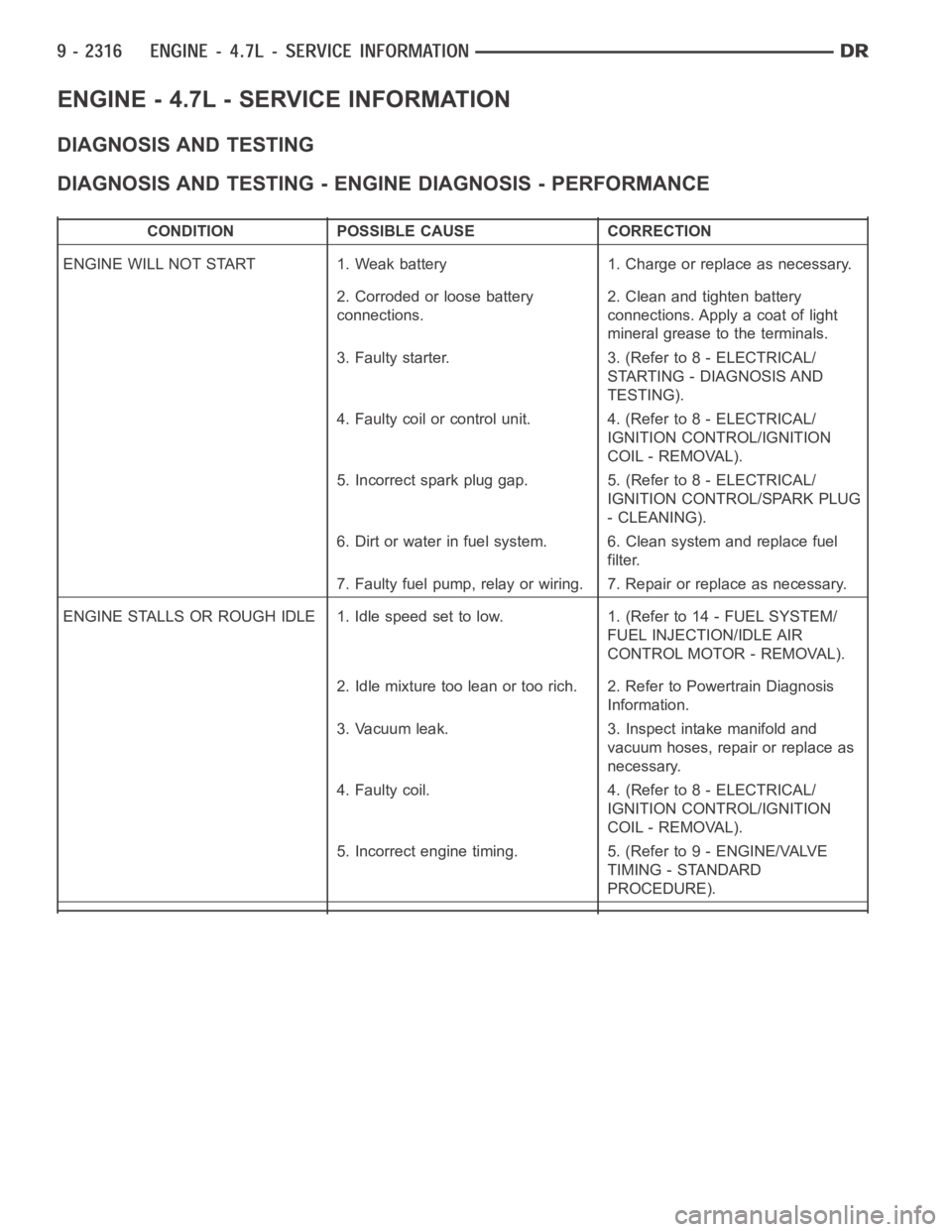
ENGINE - 4.7L - SERVICE INFORMATION
DIAGNOSIS AND TESTING
DIAGNOSIS AND TESTING - ENGINE DIAGNOSIS - PERFORMANCE
CONDITION POSSIBLE CAUSE CORRECTION
ENGINE WILL NOT START 1. Weak battery 1. Charge or replace as necessary.
2. Corroded or loose battery
connections.2. Clean and tighten battery
connections. Apply a coat of light
mineral grease to the terminals.
3. Faulty starter. 3. (Refer to 8 - ELECTRICAL/
STARTING - DIAGNOSIS AND
TESTING).
4. Faulty coil or control unit. 4. (Refer to 8 - ELECTRICAL/
IGNITION CONTROL/IGNITION
COIL - REMOVAL).
5. Incorrect spark plug gap. 5. (Refer to 8 - ELECTRICAL/
IGNITION CONTROL/SPARK PLUG
- CLEANING).
6. Dirt or water in fuel system. 6. Clean system and replace fuel
filter.
7. Faulty fuel pump, relay or wiring. 7. Repair or replace as necessary.
ENGINE STALLS OR ROUGH IDLE 1. Idle speed set to low. 1. (Refer to 14 - FUEL SYSTEM/
FUEL INJECTION/IDLE AIR
CONTROL MOTOR - REMOVAL).
2. Idle mixture too lean or too rich. 2. Refer to Powertrain Diagnosis
Information.
3. Vacuum leak. 3. Inspect intake manifold and
vacuum hoses, repair or replace as
necessary.
4. Faulty coil. 4. (Refer to 8 - ELECTRICAL/
IGNITION CONTROL/IGNITION
COIL - REMOVAL).
5. Incorrect engine timing. 5. (Refer to 9 - ENGINE/VALVE
TIMING - STANDARD
PROCEDURE).
Page 1626 of 5267
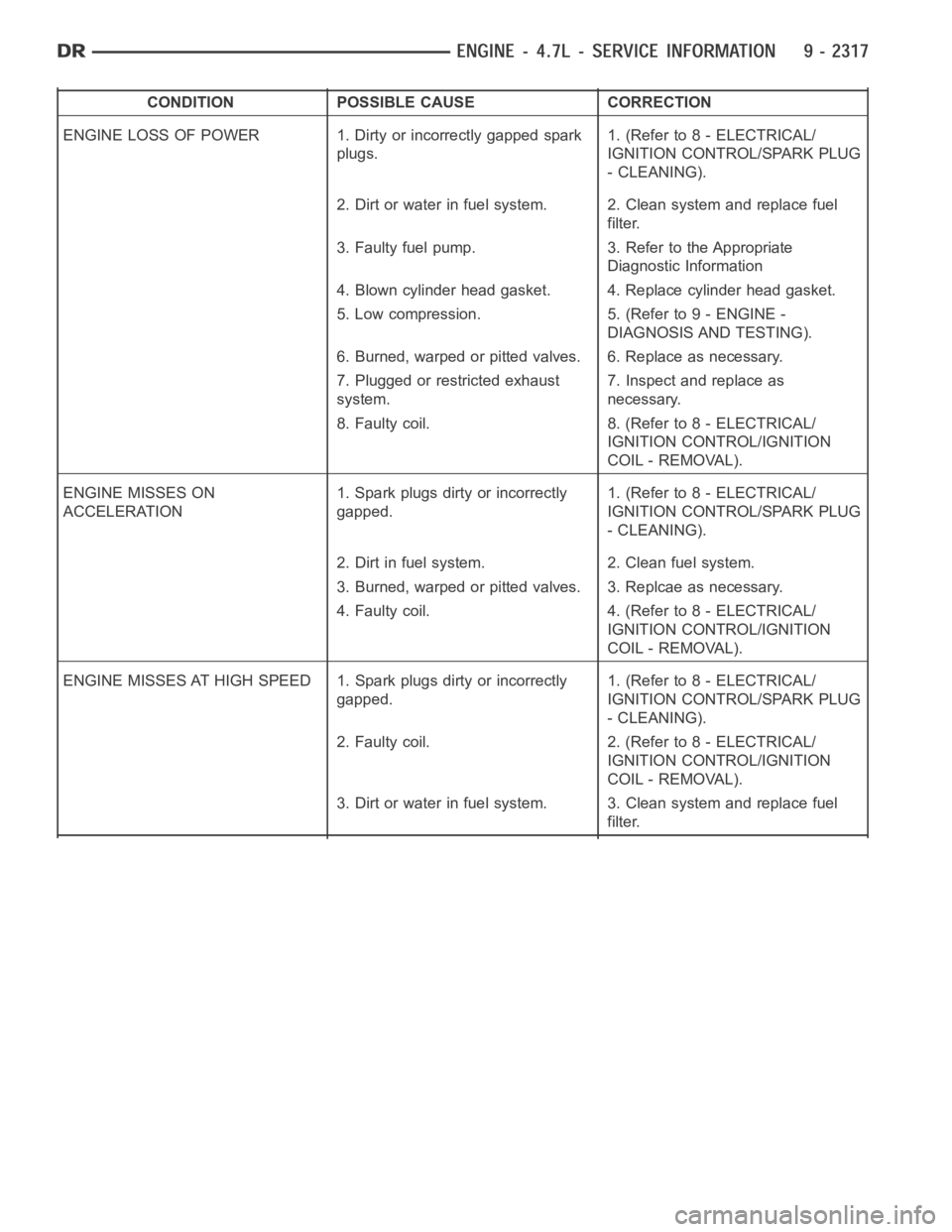
CONDITION POSSIBLE CAUSE CORRECTION
ENGINE LOSS OF POWER 1. Dirty or incorrectly gapped spark
plugs.1. (Refer to 8 - ELECTRICAL/
IGNITION CONTROL/SPARK PLUG
- CLEANING).
2. Dirt or water in fuel system. 2. Clean system and replace fuel
filter.
3. Faulty fuel pump. 3. Refer to the Appropriate
Diagnostic Information
4. Blown cylinder head gasket. 4. Replace cylinder head gasket.
5. Low compression. 5. (Refer to 9 - ENGINE -
DIAGNOSIS AND TESTING).
6. Burned, warped or pitted valves. 6. Replace as necessary.
7. Plugged or restricted exhaust
system.7. Inspect and replace as
necessary.
8. Faulty coil. 8. (Refer to 8 - ELECTRICAL/
IGNITION CONTROL/IGNITION
COIL - REMOVAL).
ENGINE MISSES ON
ACCELERATION1. Spark plugs dirty or incorrectly
gapped.1. (Refer to 8 - ELECTRICAL/
IGNITION CONTROL/SPARK PLUG
- CLEANING).
2. Dirt in fuel system. 2. Clean fuel system.
3. Burned, warped or pitted valves. 3. Replcae as necessary.
4. Faulty coil. 4. (Refer to 8 - ELECTRICAL/
IGNITION CONTROL/IGNITION
COIL - REMOVAL).
ENGINE MISSES AT HIGH SPEED 1. Spark plugs dirty or incorrectly
gapped.1. (Refer to 8 - ELECTRICAL/
IGNITION CONTROL/SPARK PLUG
- CLEANING).
2. Faulty coil. 2. (Refer to 8 - ELECTRICAL/
IGNITION CONTROL/IGNITION
COIL - REMOVAL).
3. Dirt or water in fuel system. 3. Clean system and replace fuel
filter.
Page 1627 of 5267
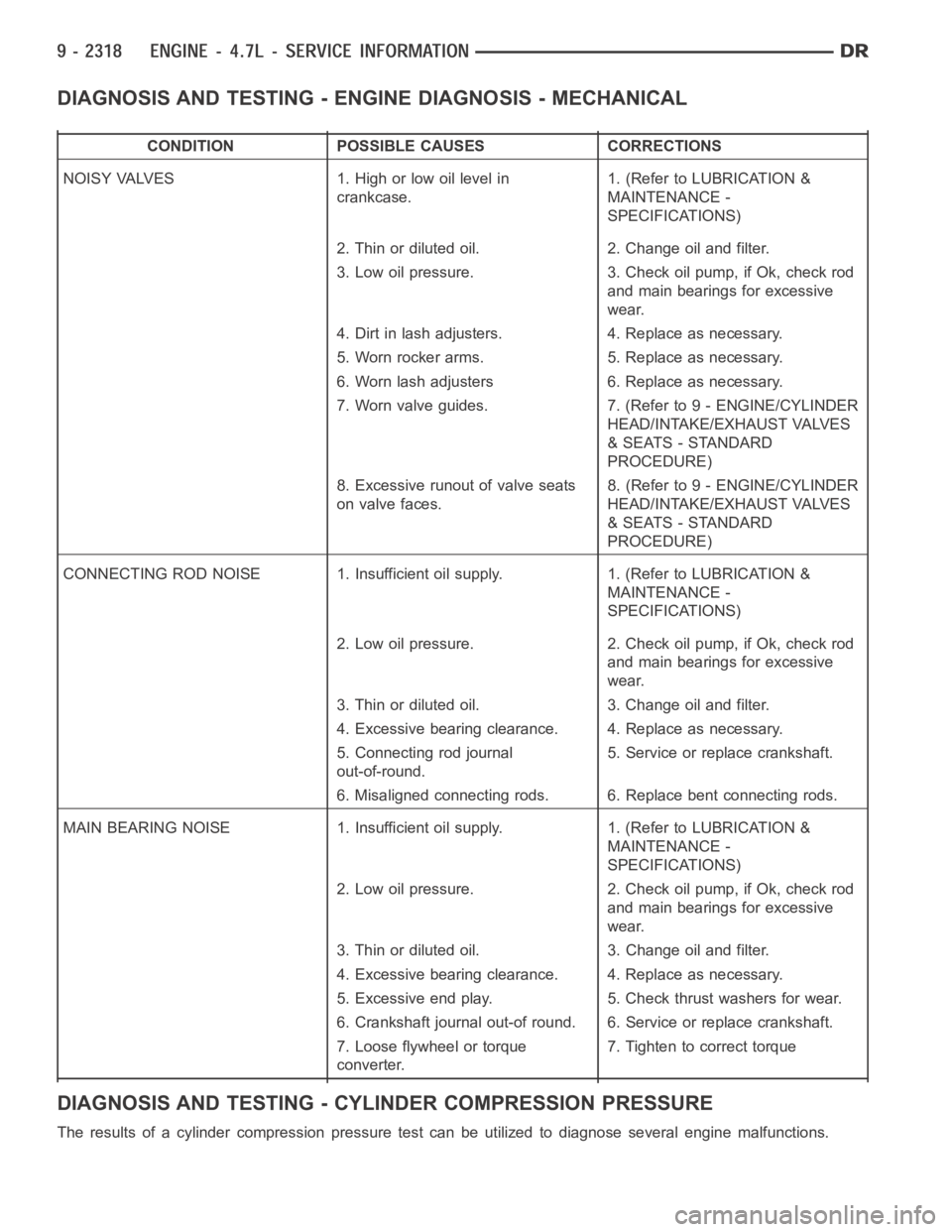
DIAGNOSIS AND TESTING - ENGINE DIAGNOSIS - MECHANICAL
CONDITION POSSIBLE CAUSES CORRECTIONS
NOISY VALVES 1. High or low oil level in
crankcase.1. (Refer to LUBRICATION &
MAINTENANCE -
SPECIFICATIONS)
2. Thin or diluted oil. 2. Change oil and filter.
3. Low oil pressure. 3. Check oil pump, if Ok, check rod
and main bearings for excessive
wear.
4. Dirt in lash adjusters. 4. Replace as necessary.
5. Worn rocker arms. 5. Replace as necessary.
6. Worn lash adjusters 6. Replace as necessary.
7. Worn valve guides. 7. (Refer to 9 - ENGINE/CYLINDER
HEAD/INTAKE/EXHAUST VALVES
& SEATS - STANDARD
PROCEDURE)
8. Excessive runout of valve seats
on valve faces.8. (Refer to 9 - ENGINE/CYLINDER
HEAD/INTAKE/EXHAUST VALVES
& SEATS - STANDARD
PROCEDURE)
CONNECTING ROD NOISE 1. Insufficient oil supply. 1. (Refer to LUBRICATION&
MAINTENANCE -
SPECIFICATIONS)
2. Low oil pressure. 2. Check oil pump, if Ok, check rod
and main bearings for excessive
wear.
3. Thin or diluted oil. 3. Change oil and filter.
4. Excessive bearing clearance. 4. Replace as necessary.
5. Connecting rod journal
out-of-round.5. Service or replace crankshaft.
6. Misaligned connecting rods. 6. Replace bent connecting rods.
MAIN BEARING NOISE 1. Insufficient oil supply. 1. (Refer to LUBRICATION &
MAINTENANCE -
SPECIFICATIONS)
2. Low oil pressure. 2. Check oil pump, if Ok, check rod
and main bearings for excessive
wear.
3. Thin or diluted oil. 3. Change oil and filter.
4. Excessive bearing clearance. 4. Replace as necessary.
5. Excessive end play. 5. Check thrust washers for wear.
6. Crankshaft journal out-of round. 6. Service or replace crankshaft.
7. Loose flywheel or torque
converter.7. Tighten to correct torque
DIAGNOSIS AND TESTING - CYLINDER COMPRESSION PRESSURE
The results of a cylinder compressionpressure test can be utilized to diagnose several engine malfunctions.
Page 1628 of 5267
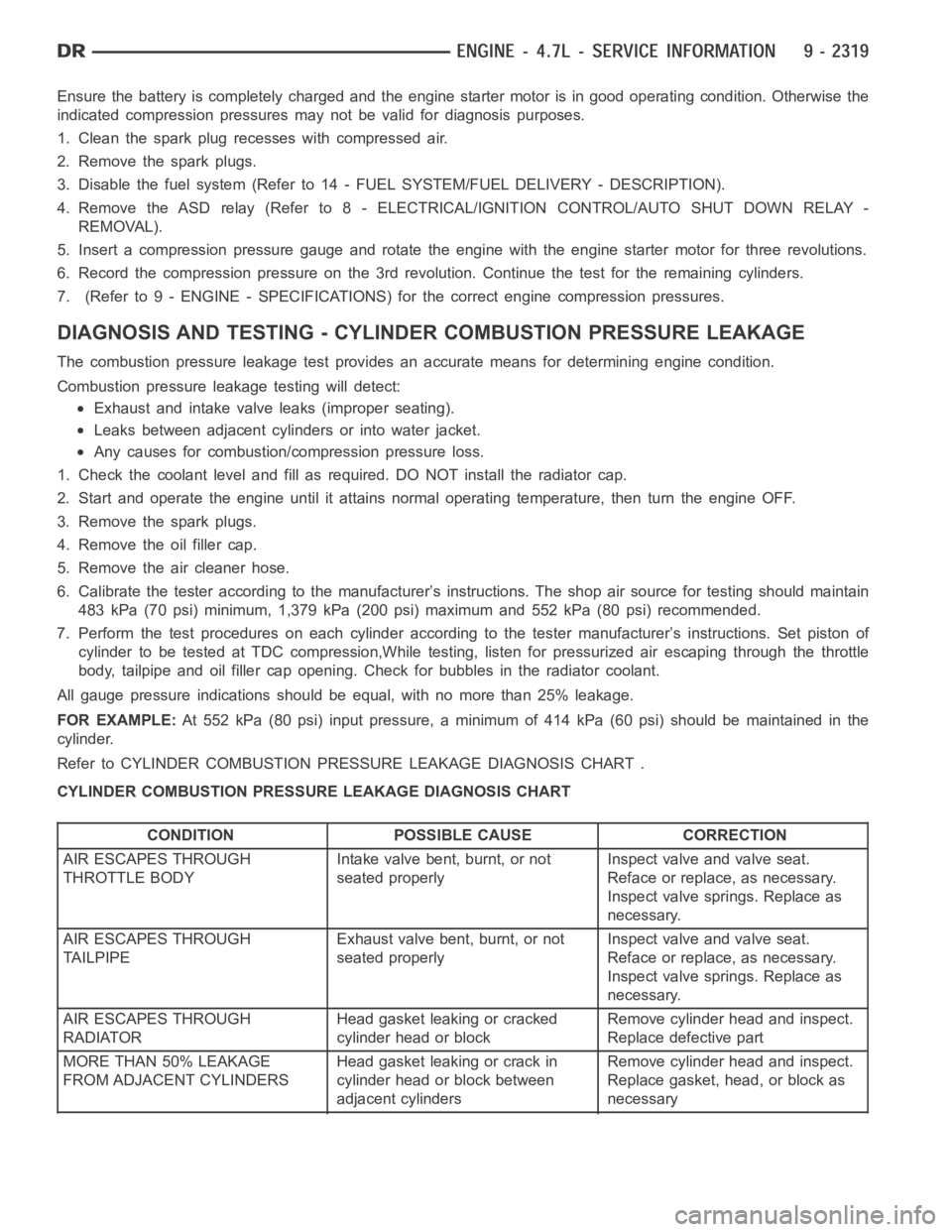
Ensurethebatteryiscompletelychargedandtheenginestartermotorisingood operating condition. Otherwise the
indicated compression pressures may not be valid for diagnosis purposes.
1. Clean the spark plug recesses with compressed air.
2. Remove the spark plugs.
3. Disable the fuel system (Refer to 14 - FUEL SYSTEM/FUEL DELIVERY - DESCRIPTION).
4. Remove the ASD relay (Refer to 8 - ELECTRICAL/IGNITION CONTROL/AUTO SHUTDOWNRELAY-
REMOVAL).
5. Insert a compression pressure gauge and rotate the engine with the engine starter motor for three revolutions.
6. Record the compression pressure on the 3rd revolution. Continue the test for the remaining cylinders.
7. (Refer to 9 - ENGINE - SPECIFICATIONS) for the correct engine compression pressures.
DIAGNOSIS AND TESTING - CYLINDERCOMBUSTION PRESSURE LEAKAGE
The combustion pressure leakage test provides an accurate means for determining engine condition.
Combustion pressure leakage testing will detect:
Exhaust and intake valve leaks (improper seating).
Leaks between adjacent cylinders or into water jacket.
Any causes for combustion/compression pressure loss.
1. Check the coolant level and fill as required. DO NOT install the radiatorcap.
2. Start and operate the engine until it attains normal operating temperature, then turn the engine OFF.
3. Remove the spark plugs.
4. Remove the oil filler cap.
5. Remove the air cleaner hose.
6. Calibrate the tester according to the manufacturer’s instructions. The shop air source for testing should maintain
483 kPa (70 psi) minimum, 1,379 kPa (200 psi) maximum and 552 kPa (80 psi) recommended.
7. Perform the test procedures on each cylinder according to the tester manufacturer’s instructions. Set piston of
cylinder to be tested at TDC compression,While testing, listen for pressurized air escaping through the throttle
body, tailpipe and oil filler cap opening. Check for bubbles in the radiator coolant.
All gauge pressure indications should be equal, with no more than 25% leakage.
FOR EXAMPLE:At 552 kPa (80 psi) input pressure, a minimum of 414 kPa (60 psi) should be maintained in the
cylinder.
Refer to CYLINDER COMBUSTION PRESSURE LEAKAGE DIAGNOSIS CHART .
CYLINDER COMBUSTION PRESSURE LEAKAGE DIAGNOSIS CHART
CONDITION POSSIBLE CAUSE CORRECTION
AIR ESCAPES THROUGH
THROTTLE BODYIntake valve bent, burnt, or not
seated properlyInspect valve and valve seat.
Reface or replace, as necessary.
Inspect valve springs. Replace as
necessary.
AIR ESCAPES THROUGH
TAILPIPEExhaust valve bent, burnt, or not
seated properlyInspect valve and valve seat.
Reface or replace, as necessary.
Inspect valve springs. Replace as
necessary.
AIR ESCAPES THROUGH
RADIATORHead gasket leaking or cracked
cylinder head or blockRemove cylinder head and inspect.
Replace defective part
MORE THAN 50% LEAKAGE
FROM ADJACENT CYLINDERSHead gasket leaking or crack in
cylinder head or block between
adjacent cylindersRemove cylinder head and inspect.
Replace gasket, head, or block as
necessary
Page 1629 of 5267
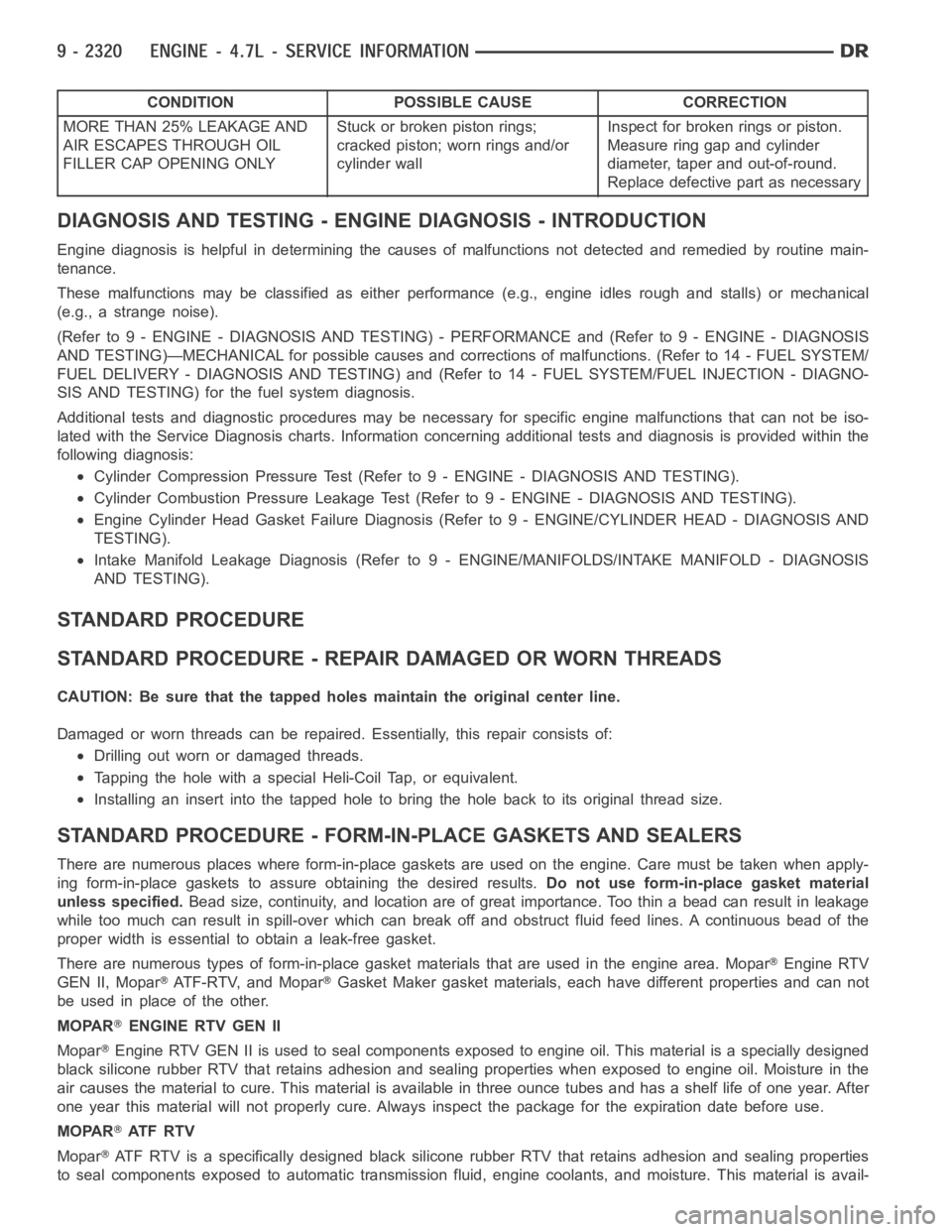
CONDITION POSSIBLE CAUSE CORRECTION
MORE THAN 25% LEAKAGE AND
AIR ESCAPES THROUGH OIL
FILLER CAP OPENING ONLYStuckorbrokenpistonrings;
cracked piston; worn rings and/or
cylinder wallInspect for broken rings or piston.
Measure ring gap and cylinder
diameter, taper and out-of-round.
Replace defective part as necessary
DIAGNOSIS AND TESTING - ENGINE DIAGNOSIS - INTRODUCTION
Engine diagnosis is helpful in determining the causes of malfunctions notdetected and remedied by routine main-
tenance.
These malfunctions may be classified as either performance (e.g., engineidles rough and stalls) or mechanical
(e.g., a strange noise).
(Refer to 9 - ENGINE - DIAGNOSIS AND TESTING) - PERFORMANCE and (Refer to 9 - ENGINE - DIAGNOSIS
AND TESTING)—MECHANICAL for possible causes and corrections of malfunctions. (Refer to 14 - FUEL SYSTEM/
FUEL DELIVERY - DIAGNOSIS AND TESTING) and (Refer to 14 - FUEL SYSTEM/FUEL INJECTION - DIAGNO-
SIS AND TESTING) for the fuel system diagnosis.
Additional tests and diagnostic procedures may be necessary for specificengine malfunctions that can not be iso-
lated with the Service Diagnosis charts. Information concerning additional tests and diagnosis is provided within the
following diagnosis:
Cylinder Compression Pressure Test (Refer to 9 - ENGINE - DIAGNOSIS AND TESTING).
Cylinder Combustion Pressure LeakageTest (Refer to 9 - ENGINE - DIAGNOSISAND TESTING).
Engine Cylinder Head Gasket Failure Diagnosis (Refer to 9 - ENGINE/CYLINDER HEAD - DIAGNOSIS AND
TESTING).
Intake Manifold Leakage Diagnosis (Refer to 9 - ENGINE/MANIFOLDS/INTAKEMANIFOLD - DIAGNOSIS
AND TESTING).
STANDARD PROCEDURE
STANDARD PROCEDURE - REPAIR DAMAGED OR WORN THREADS
CAUTION: Be sure that the tapped holes maintain the original center line.
Damaged or worn threads can be repaired. Essentially, this repair consistsof:
Drilling out worn or damaged threads.
Tapping the hole with a special Heli-Coil Tap, or equivalent.
Installing an insert into the tapped hole to bring the hole back to its original thread size.
STANDARD PROCEDURE - FORM-IN-PLACE GASKETS AND SEALERS
There are numerous places where form-in-place gaskets are used on the engine. Care must be taken when apply-
ing form-in-place gaskets to assure obtaining the desired results.Do not use form-in-place gasket material
unless specified.Bead size, continuity, and location are of great importance. Too thin a bead can result in leakage
while too much can result in spill-overwhich can break off and obstruct fluid feed lines. A continuous bead of the
proper width is essential to obtain a leak-free gasket.
There are numerous types of form-in-place gasket materials that are used in the engine area. Mopar
Engine RTV
GEN II, Mopar
ATF-RTV, and MoparGasket Maker gasket materials, each have different properties and can not
be used in place of the other.
MOPAR
ENGINE RTV GEN II
Mopar
Engine RTV GEN II is used to seal components exposed to engine oil. This material is a specially designed
black silicone rubber RTV that retains adhesion and sealing properties when exposed to engine oil. Moisture in the
air causes the material to cure. This material is available in three ounce tubes and has a shelf life of one year. After
one year this material will not properly cure. Always inspect the package for the expiration date before use.
MOPAR
AT F R T V
Mopar
ATF RTV is a specifically designed black silicone rubber RTV that retains adhesion and sealing properties
to seal components exposed to automatic transmission fluid, engine coolants, and moisture. This material is avail-
Page 1630 of 5267
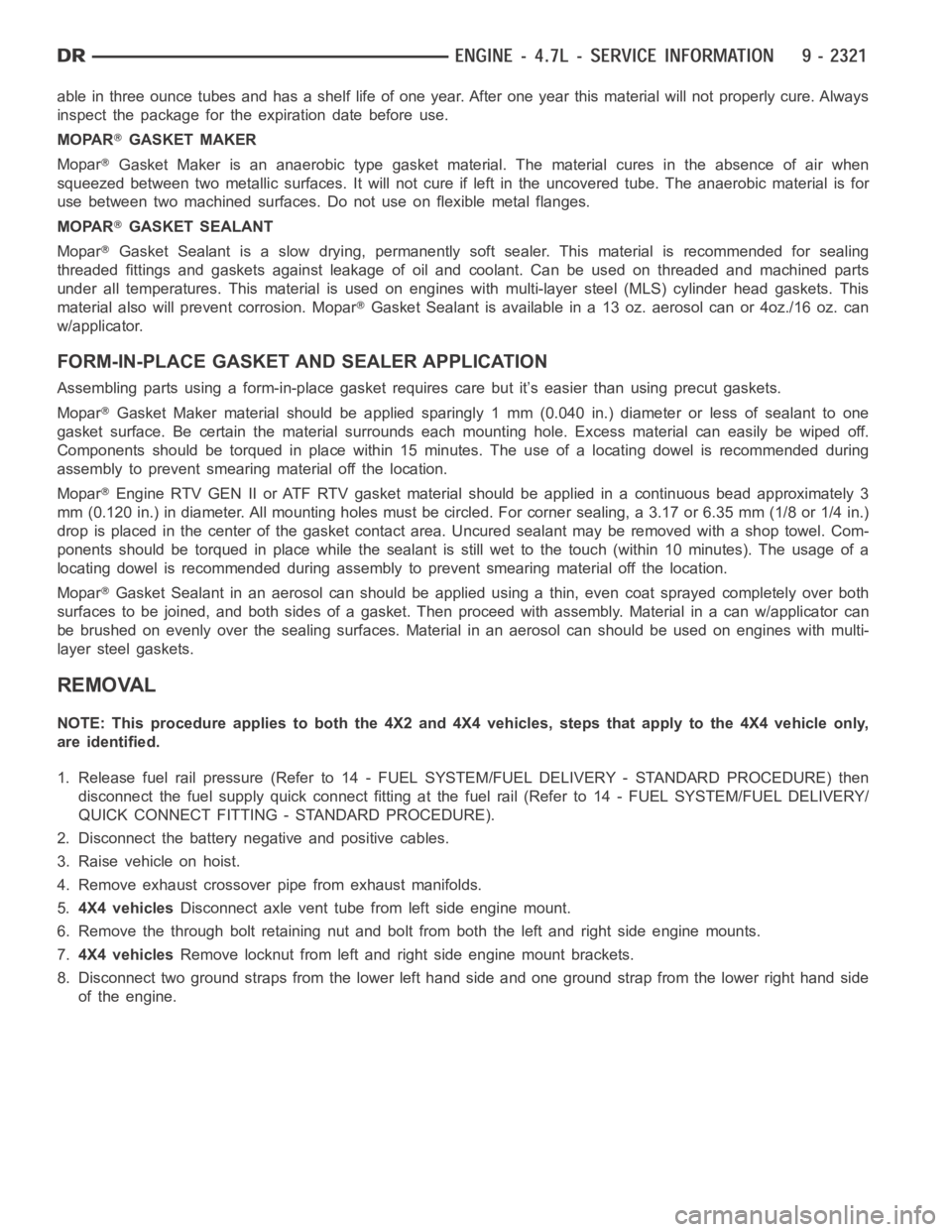
able in three ounce tubes and has a shelf life of one year. After one year thismaterial will not properly cure. Always
inspect the package for the expiration date before use.
MOPAR
GASKET MAKER
Mopar
Gasket Maker is an anaerobic type gasket material. The material cures in the absence of air when
squeezed between two metallic surfaces. It will not cure if left in the uncovered tube. The anaerobic material is for
use between two machined surfaces. Do not use on flexible metal flanges.
MOPAR
GASKET SEALANT
Mopar
Gasket Sealant is a slow drying, permanently soft sealer. This material isrecommended for sealing
threaded fittings and gaskets against leakage of oil and coolant. Can be used on threaded and machined parts
under all temperatures. This material is used on engines with multi-layersteel (MLS) cylinder head gaskets. This
material also will prevent corrosion. Mopar
Gasket Sealant is available in a 13 oz. aerosol can or 4oz./16 oz. can
w/applicator.
FORM-IN-PLACE GASKET AND SEALER APPLICATION
Assembling parts using a form-in-place gasket requires care but it’s easier than using precut gaskets.
Mopar
Gasket Maker material should be applied sparingly 1 mm (0.040 in.) diameter or less of sealant to one
gasket surface. Be certain the material surrounds each mounting hole. Excess material can easily be wiped off.
Components should be torqued in place within 15 minutes. The use of a locating dowel is recommended during
assembly to prevent smearing material off the location.
Mopar
Engine RTV GEN II or ATF RTV gasket material should be applied in a continuous bead approximately 3
mm (0.120 in.) in diameter. All mounting holes must be circled. For corner sealing, a 3.17 or 6.35 mm (1/8 or 1/4 in.)
drop is placed in the center of the gasket contact area. Uncured sealant maybe removed with a shop towel. Com-
ponents should be torqued in place while the sealant is still wet to the touch (within 10 minutes). The usage of a
locating dowel is recommended during assembly to prevent smearing material off the location.
Mopar
Gasket Sealant in an aerosol can should be applied using a thin, even coat sprayed completely over both
surfaces to be joined, and both sides of a gasket. Then proceed with assembly. Material in a can w/applicator can
be brushed on evenly over the sealing surfaces. Material in an aerosol can shouldbeusedonengineswithmulti-
layer steel gaskets.
REMOVAL
NOTE:Thisprocedureappliestoboththe4X2and4X4vehicles,stepsthatapply to the 4X4 vehicle only,
are identified.
1. Release fuel rail pressure (Refer to 14 - FUEL SYSTEM/FUEL DELIVERY - STANDARD PROCEDURE) then
disconnect the fuel supply quick connect fitting at the fuel rail (Refer to14 - FUEL SYSTEM/FUEL DELIVERY/
QUICK CONNECT FITTING - STANDARD PROCEDURE).
2. Disconnect the battery negative and positive cables.
3. Raise vehicle on hoist.
4. Remove exhaust crossover pipe from exhaust manifolds.
5.4X4 vehiclesDisconnect axle vent tube from left side engine mount.
6. Remove the through bolt retaining nut and bolt from both the left and right side engine mounts.
7.4X4 vehiclesRemove locknut from left and right side engine mount brackets.
8. Disconnect two ground straps from the lower left hand side and one groundstrap from the lower right hand side
of the engine.